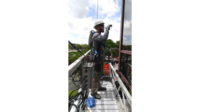Heat Advisory
Beat the Heat: Summer Tips for Roofing Contractors
Holcim knows crews are battling extreme heat conditions in many parts of the county and offers practical tips for worker safety and product protection

The summer of 2023 is becoming the summer of superlatives. Scientists say the first two weeks of July have been the Earth's hottest since humans have kept temperature records. The average global temperature in July is an unprecedented 17.2 degrees Celsius, or 62.9 degrees Fahrenheit.
— Top-of-fold photo courtesy of Roof Top Industries; second photo courtesy of Holcim Elevate
 Last summer ranked among the hottest on record, according to data from the National Aeronautics and Space Administration and the National Oceanic and Atmospheric Administration, and we are seeing the same in 2023. With that said, Elevate suggests the following tips for roofing professionals to consider this summer:
Last summer ranked among the hottest on record, according to data from the National Aeronautics and Space Administration and the National Oceanic and Atmospheric Administration, and we are seeing the same in 2023. With that said, Elevate suggests the following tips for roofing professionals to consider this summer:
Roofing Crew Safety
- Begin the workday as early as possible, as the temperatures are cooler in the morning.
- Don’t skip the protective gear. Vests, hard hats, gloves, and fall protection gear help prevent injuries.
- Wear all light-colored cotton or color-reflecting comfortable clothing while working in the heat. Synthetic fabrics like nylon and polyester may accumulate static charge more easily.
- Wear safety glasses with UV protection and apply water-resistant sunscreen with a minimum SPF of 30 as needed throughout the day.
- Stay well hydrated. Take periodic breaks in the shade and hydrate frequently. Alternate energy or sports drinks with water, and pass on sodas and caffeinated beverages.
- Keep a fire extinguisher on hand at all times, and regularly contain and remove job site debris and rubbish.
- Train your team to recognize the signs of heat exhaustion and heat stroke in themselves and others. Have a planned method of egress from the roof.
If anyone experiences any of the following symptoms, move them to a safe place and seek immediate medical attention:
- Dizziness
- Fatigue
- Headache
- Nausea
- Rapid heartbeat
- Confusion

Protection of Roofing Materials
- Store primers, adhesives, and cleaners out of direct sunlight and away from your immediate work area when not in use. Do the same with empty containers, used brushes, and other debris.
- In the case of spray-applied adhesives, do not remove a canister from its carton until just prior to application. Do not leave hoses or nozzles in the open before or after use or overnight.
- Keep product information sheets and Safety Data Sheets readily accessible.
- For many adhesives, heat accelerates dry times and causes them to achieve their full bond faster. Adjust working times and application rates accordingly.
- Pop-up storms are more common in the summer, so only attempt to install as much material as you can reasonably complete that day. Sudden drops in temperature may cause thermal shock, which can negatively affect the installed materials.
Finishing projects on time and on budget is important, but the safety of yourself and those around you should always be your number one concern. The safest roofing crews are often the most productive. Happy summer roofing!
Robert Anderson is a regional account manager at Holcim Building Envelope. Anderson is responsible for promoting Holcim’s premium roofing system offerings to building owners, building envelope consultants, and the architectural community. He has spent more than 20 years with Holcim in various capacities.
Looking for a reprint of this article?
From high-res PDFs to custom plaques, order your copy today!





